Greek cuisine is beloved worldwide for its vibrant flavors and fresh ingredients. From savory dips to hearty main dishes, there’s a Greek recipe for every craving.
Whether you’re a seasoned cook or a beginner in the kitchen, these fifteen Greek recipes will bring a taste of the Mediterranean to your home. Get ready to explore a range of delicious dishes that showcase the very best of Greek culinary tradition.
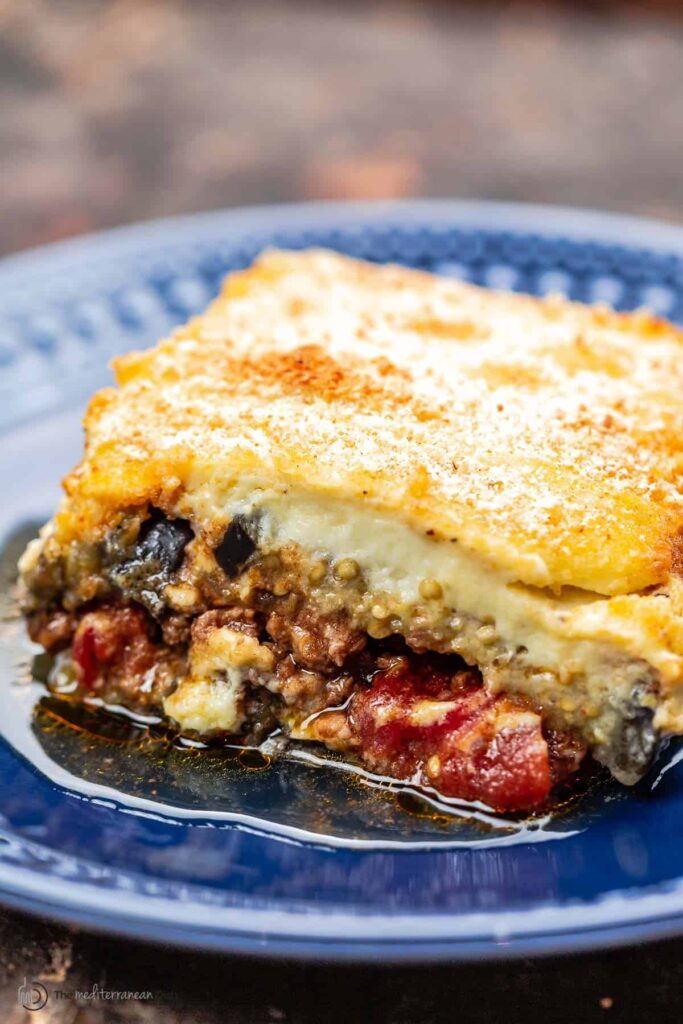
1) Moussaka
Moussaka is a staple in Greek cuisine, known for its hearty layers and rich flavors. It begins with a layer of sliced eggplants, sometimes mixed with potatoes. The eggplants are often brushed with olive oil and broiled until golden brown.
Next, you’ll prepare a savory meat sauce. Ground beef or lamb is browned with onions and garlic, then simmered with tomatoes, wine, and a mix of spices. This meat sauce provides a deeply savory element to the dish.
After the meat sauce, a layer of creamy béchamel sauce is added. This is made by cooking flour and butter together, then slowly whisking in milk until thick and smooth. Some recipes suggest adding grated cheese for extra flavor.
To assemble, you layer the ingredients in a baking dish. Start with eggplants, add the meat sauce, and top with the béchamel. Baking it until the top is golden brown and bubbly ensures all the flavors meld together beautifully.
Moussaka is often served warm and is a comforting dish that highlights traditional Greek flavors. Enjoy it with a fresh Greek salad or crusty bread for a complete meal.
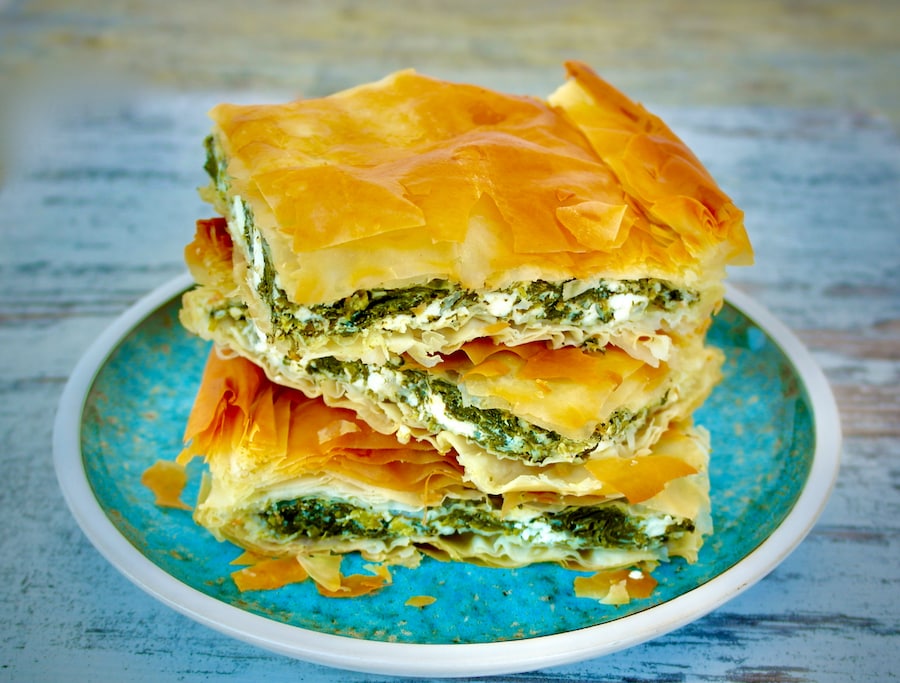
2) Spanakopita
Spanakopita is a traditional Greek spinach pie. It’s made using layers of flaky phyllo dough. Each layer is brushed with olive oil to create a crisp texture.
The filling includes spinach and feta cheese. You also mix in sautéed onions, herbs, and sometimes a bit of nutmeg for extra flavor.
To assemble, lay down a sheet of phyllo dough in a baking pan. Brush it lightly with olive oil. Repeat this step with a few more layers. Spread the spinach and cheese mixture evenly.
Fold any overhanging dough over the top of the filling. This helps to seal in the mixture. Bake the spanakopita in a preheated oven at around 325-350 degrees Fahrenheit.
Cooking time is usually about an hour. You know it’s done when the phyllo crust is golden brown. Let it rest for a few minutes before serving. Cut into squares or triangles and enjoy!
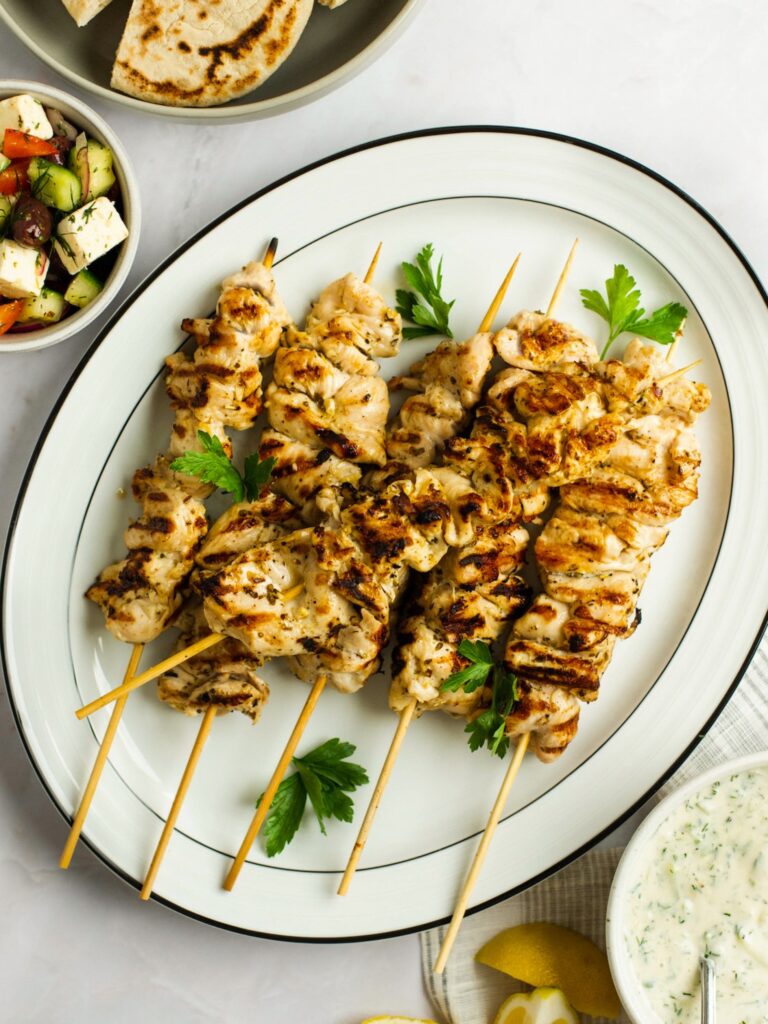
3) Souvlaki
Souvlaki is a classic Greek dish that features skewered and grilled meat. It’s popular for its delicious flavors and versatility. You can use chicken, pork, or even lamb.
To start, you’ll need to marinate your meat. A marinade typically consists of olive oil, garlic, oregano, rosemary, paprika, salt, and pepper. Adding lemon juice and white wine can enhance the flavors.
Cut the meat into small, bite-sized pieces. Place them in a bowl or zip-lock bag with the marinade. Make sure the meat is well-coated. Let it sit in the fridge for at least 30 minutes; longer is better for deeper flavor.
Next, prepare your skewers. Thread the marinated meat onto the skewers. If you’re using wooden skewers, soak them in water first to prevent burning.
Grill the skewers on medium-high heat, turning occasionally. It typically takes about 8 to 10 minutes to cook through. The meat should have a nice color on all sides.
Serve your souvlaki with warm pita bread and Tzatziki sauce. Tzatziki is a yogurt-based sauce with cucumber, garlic, and dill. It adds a refreshing taste to the dish. Enjoy your souvlaki as a main course or a hearty snack.
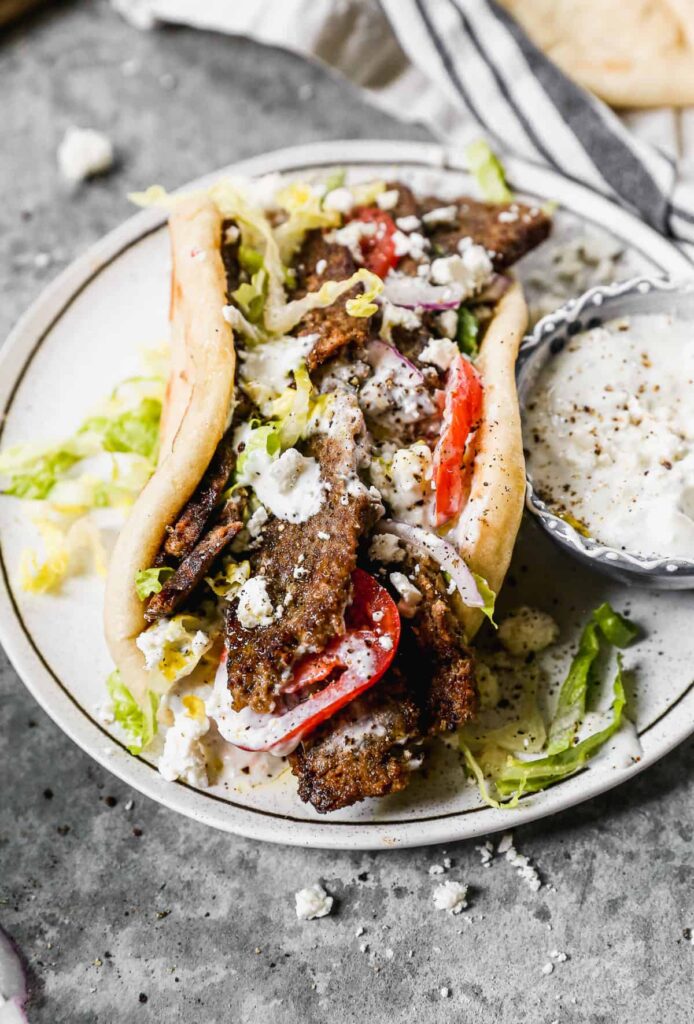
4) Gyro
Gyros are a delicious staple of Greek cuisine. They are typically made with either lamb, chicken, or pork. The meat is well-seasoned with spices like garlic, oregano, and lemon juice. Then it is grilled until perfection.
Gyros are usually served wrapped in warm pita bread. They often come with fresh toppings like tomatoes, onions, and lettuce. Tzatziki sauce is a must-have addition. This creamy sauce made from yogurt, cucumber, and garlic enhances every bite.
To make gyros at home, marinate your choice of meat for at least an hour. Grill the meat until it is golden brown. Prepare your pita by lightly oiling and warming it in the oven. Once everything is ready, assemble your gyro by adding the meat, toppings, and a generous dollop of tzatziki sauce.
Enjoy this Greek favorite as a hearty meal that’s full of flavor.
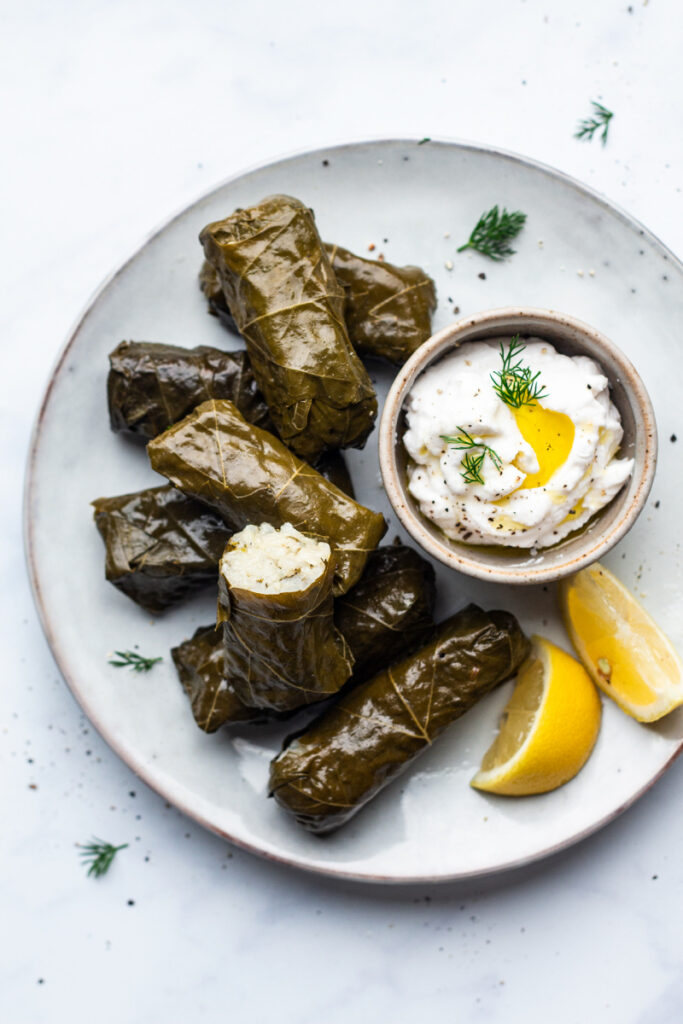
5) Dolmades
Dolmades are a staple in Greek cuisine, known for their unique flavors and textures. These are grape leaves stuffed with a mixture of rice, herbs, and sometimes meat.
To prepare dolmades, start by rinsing the rice and frying it with onions in olive oil. This gives the rice a mild, sweet flavor. Next, you can add herbs like dill, mint, and parsley, along with seasonings such as salt and pepper.
Once the filling is ready, place a small amount on each grape leaf and roll them up tightly. Be sure to fold the sides in to create a neat package. Place some grape leaves at the bottom of a pot to prevent sticking, then put the rolled dolmades on top.
Pour broth or water over the dolmades until they are slightly covered, usually about 4 cups. Some recipes recommend adding lemon juice for extra flavor. Cover the pot and cook on medium heat until the liquid is absorbed, which typically takes around 30 minutes.
Allow them to cool slightly before serving. You can enjoy dolmades warm or at room temperature, often with a drizzle of olive oil or a squeeze of fresh lemon juice.
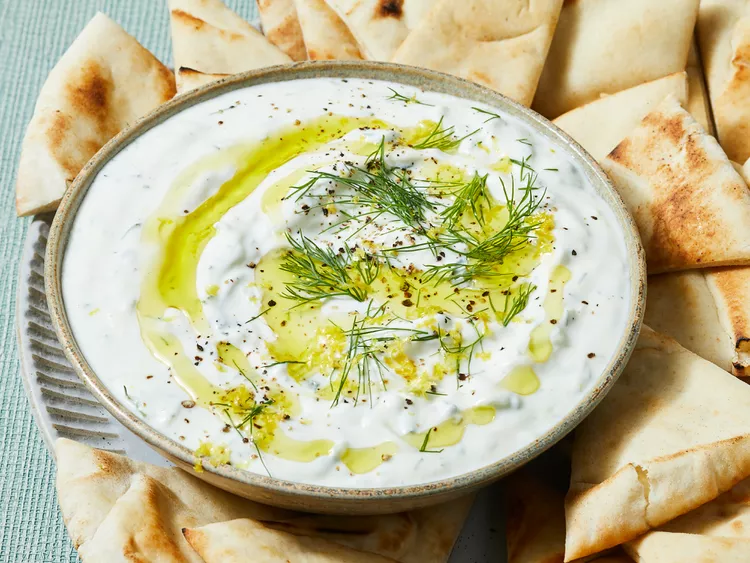
6) Tzatziki
Tzatziki is a popular Greek sauce made from yogurt, cucumber, garlic, olive oil, lemon juice, and herbs. It’s a cool, creamy addition to many dishes or a great dip on its own.
To make tzatziki, start by grating the cucumber and squeezing out the excess water. This helps keep the sauce thick and rich.
Combine the cucumber with Greek yogurt in a bowl. Add minced garlic, olive oil, lemon juice, salt, and pepper. You can also mix in fresh herbs like dill or mint for extra flavor.
Let the mixture chill in the refrigerator for a few hours to allow the flavors to meld together. Tzatziki pairs well with grilled meats, pita bread, and fresh vegetables.
This simple yet flavorful sauce is a staple in Greek cuisine and adds a refreshing note to your meals.
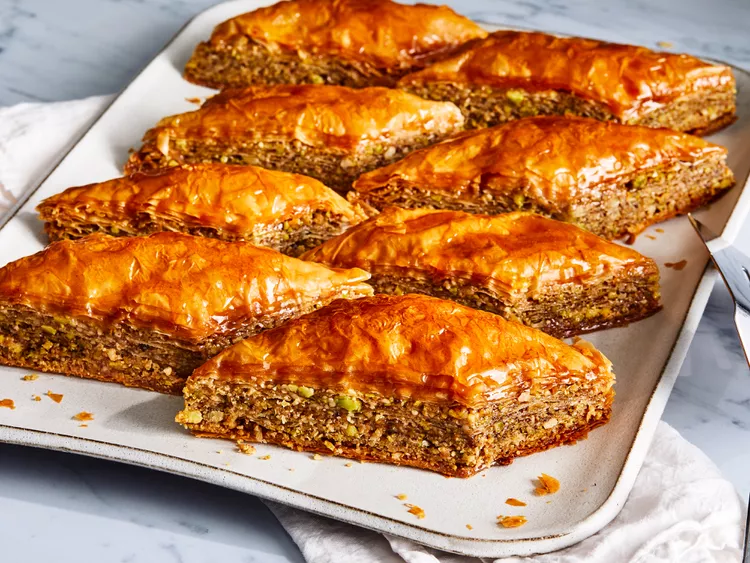
7) Baklava
Baklava is a sweet pastry made with layers of phyllo dough. Between these layers, you will find a mixture of chopped nuts, usually walnuts, almonds, or pistachios. Each layer is brushed with melted butter to create a crisp and rich texture.
You start by stacking about eight sheets of phyllo dough. Brush each layer with butter before adding a mixture of chopped nuts and cinnamon. Repeat until you use all the nut mixture, then top with more phyllo sheets.
Once layered, bake the Baklava. Preheat your oven to 350 degrees Fahrenheit. Bake until the phyllo is golden and crisp.
While the Baklava is baking, make the syrup. Combine sugar, water, honey, and lemon juice in a saucepan. Boil this mixture until the sugar dissolves, and then let it cool.
After you take the Baklava from the oven, pour the cooled syrup over the hot pastry. Let it soak for several hours or overnight. This step allows the syrup to penetrate the layers, making the Baklava sweet and moist.
Baklava is typically cut into small diamond or square pieces before serving. Enjoy this classic Greek dessert with a cup of coffee or tea.
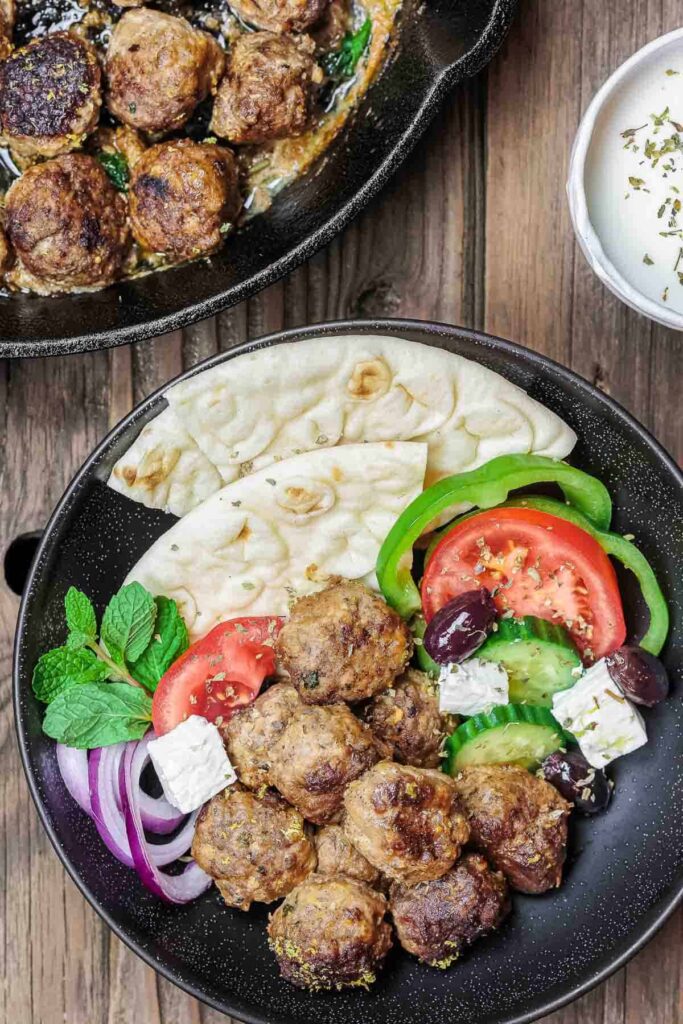
8) Keftedes
Keftedes, also known as Greek meatballs, are a delightful dish often seasoned with herbs and spices. You can make them with ground pork, beef, or a mixture of both. Mint, garlic, and parsley add a fresh taste to the meat.
To prepare keftedes, mix the ground meat with finely chopped garlic, mint, parsley, an egg, breadcrumbs, and crumbled feta. Shape the mixture into small balls.
You can cook them in different ways. Frying is the traditional method. Heat oil in a frying pan and cook the meatballs in batches until golden brown on all sides.
If you prefer a healthier option, you can bake them. Preheat your oven to 200°C (390°F). Place the meatballs on a baking sheet, ensuring they are about an inch apart. Bake until they are browned.
Sometimes keftedes are served with a lemony sauce. To make the sauce, mix an egg yolk with lemon juice and chicken broth. Pour this mixture into the skillet with the meatballs and cook until the sauce thickens.
Keftedes are often enjoyed as an appetizer or a main course. They pair well with pita bread, tzatziki, or a fresh Greek salad. The blend of herbs and spices gives them a unique flavor that is distinctly Greek.
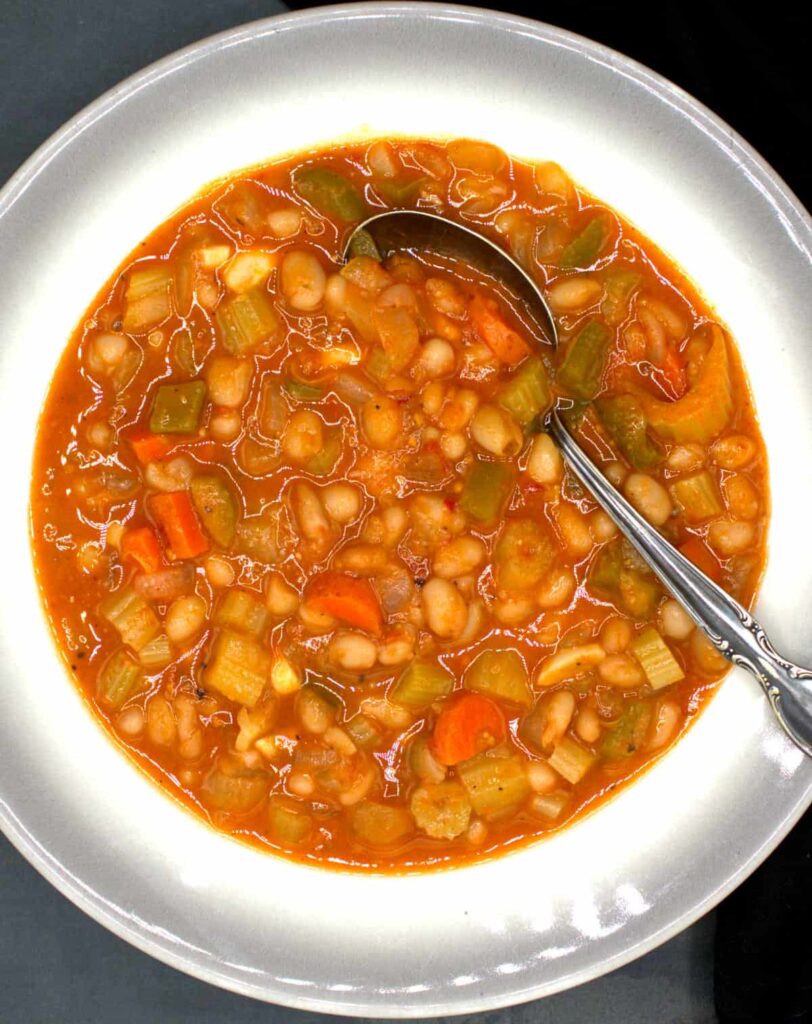
9) Fasolada
Fasolada is a traditional Greek bean soup. It’s often called the national dish of Greece. You will find it made with simple and hearty ingredients.
You start with white beans, typically cannellini or navy beans. They need to be soaked overnight to soften. Then, you cook them until they are tender.
Vegetables are essential in this dish. Commonly used ones include onions, celery, carrots, and garlic. You chop these into small pieces and add them to the beans.
Olive oil is key in Fasolada. You use a generous amount, around 3 to 4 tablespoons. This gives the soup its rich flavor.
Seasonings like bay leaves, cumin, and paprika add depth. Some recipes also include cayenne pepper for a bit of heat.
Once everything is in the pot, you bring it to a boil. Then, you reduce the heat and let it simmer. This helps blend all the flavors together.
Fasolada is usually served with crusty bread. It’s a comforting and nutritious meal, especially in colder months.
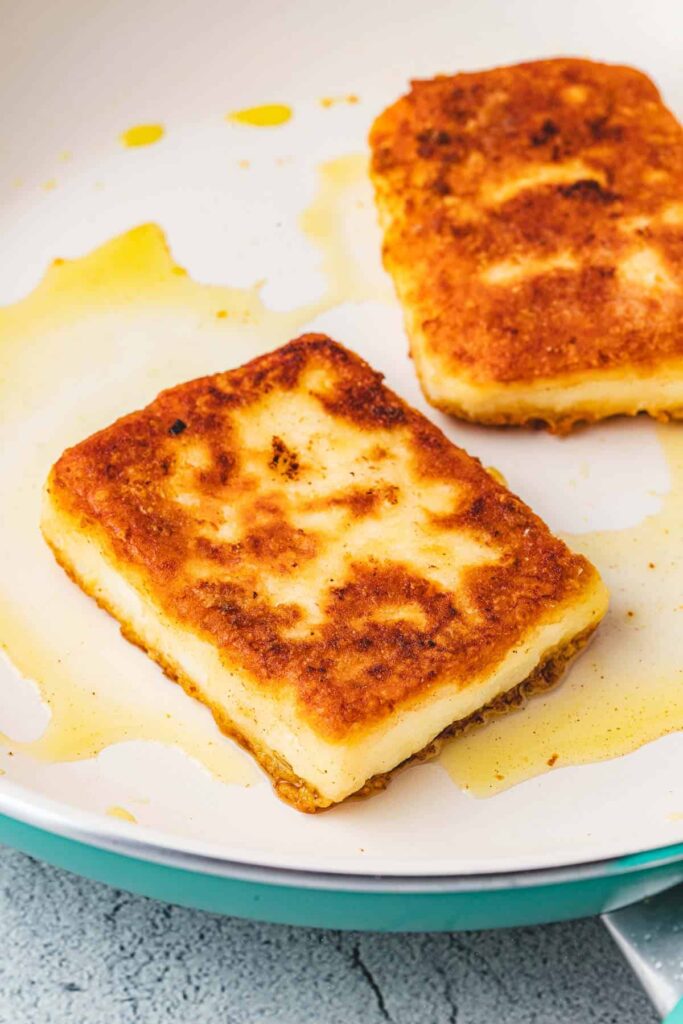
10) Saganaki
Saganaki is a classic Greek dish made with fried cheese. It’s known for its crispy exterior and warm, gooey inside. You can find it in many Greek restaurants as an appetizer enjoyed with lemon wedges.
To prepare saganaki, start with a firm cheese like Kefalotyri or Graviera. These cheeses hold their shape well when fried. Cut the cheese into thick slices, about half an inch.
Next, wet the cheese slices with water and coat them in flour. Shake off any extra flour. Heat olive oil in a skillet over medium heat until it’s hot but not smoking.
Place the floured cheese in the pan and fry. Cook each side for about two minutes until golden brown. Use a spatula to flip the cheese carefully so it doesn’t break apart.
For a special touch, you can ignite the cheese with a splash of brandy and shout “Opa!” It’s a fun way to impress your guests.
Squeeze fresh lemon juice over the saganaki before serving. The bright citrus cuts through the richness of the cheese, making every bite delightful. Enjoy saganaki with warm bread or as part of a mezze platter.
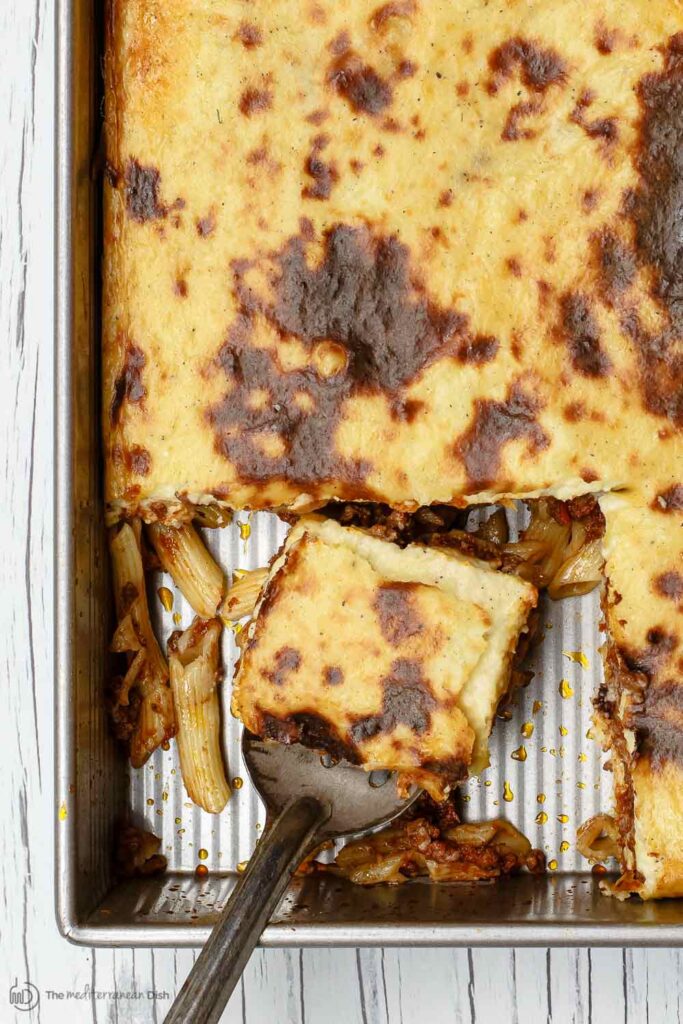
11) Pastitsio
Pastitsio is often called Greek lasagna. It’s a comforting dish with layers of pasta, rich meat sauce, and creamy béchamel.
Start by making the meat sauce. Heat olive oil in a large skillet over medium-high heat. Add chopped onions and garlic, cooking until softened. Brown the ground beef, breaking it up with a wooden spoon.
Add tomatoes, spices like cinnamon and allspice, and some salt. Let the sauce simmer to blend the flavors. While it cooks, you can prepare the béchamel sauce. Heat olive oil in a saucepan, then stir in flour, salt, and pepper. Slowly add milk, stirring until it thickens.
Boil pasta until al dente. Layer half in a greased casserole dish, add the meat sauce, and cover with the remaining pasta. Pour the béchamel sauce over the top and spread it evenly. Bake the dish until the top is golden brown.
Pastitsio is best served warm. Enjoy this classic Greek comfort food with a crisp salad on the side.
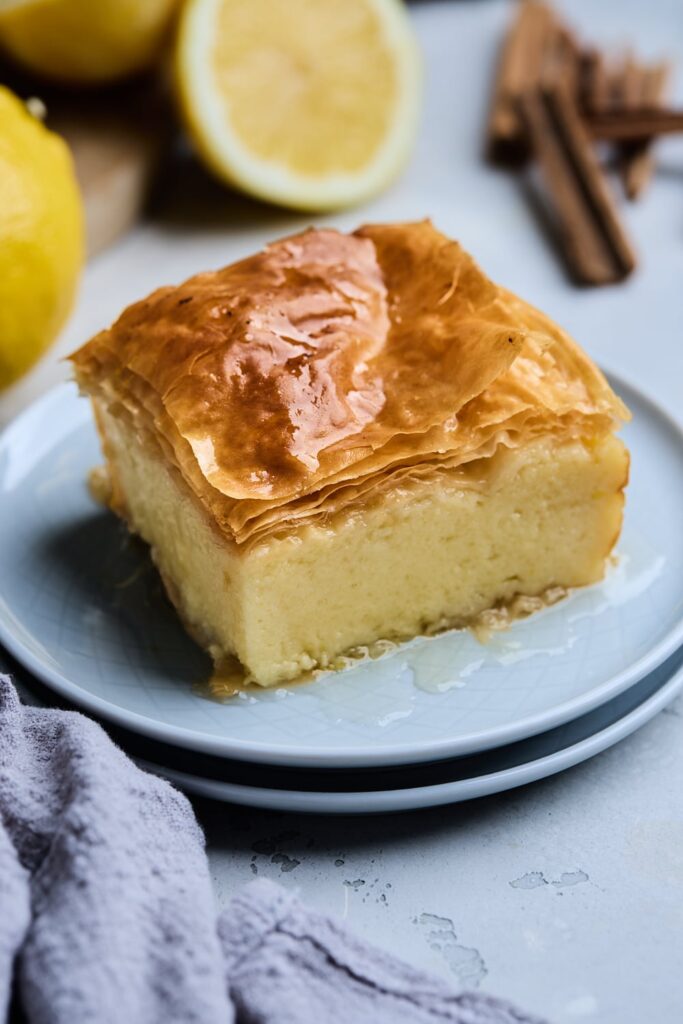
12) Galaktoboureko
Galaktoboureko is a popular Greek dessert made with layers of crispy phyllo dough filled with sweet semolina custard. It is then soaked in a fragrant syrup.
To make the custard, mix semolina, milk, sugar, and vanilla extract in a pot over medium heat. In a bowl, whisk eggs, then slowly combine them with the hot milk mixture.
Layer sheets of phyllo dough in a buttered baking dish, brushing each layer with melted butter. Pour the custard over the phyllo layers, then cover with more buttered phyllo sheets.
Bake in a preheated oven until the phyllo is golden and crisp. Meanwhile, make the syrup by boiling water, sugar, cinnamon, and lemon slices.
Pour the cold syrup over the hot galaktoboureko as soon as it comes out of the oven. Allow it to sit until the syrup is fully absorbed before serving. Enjoy your galaktoboureko warm or at room temperature.
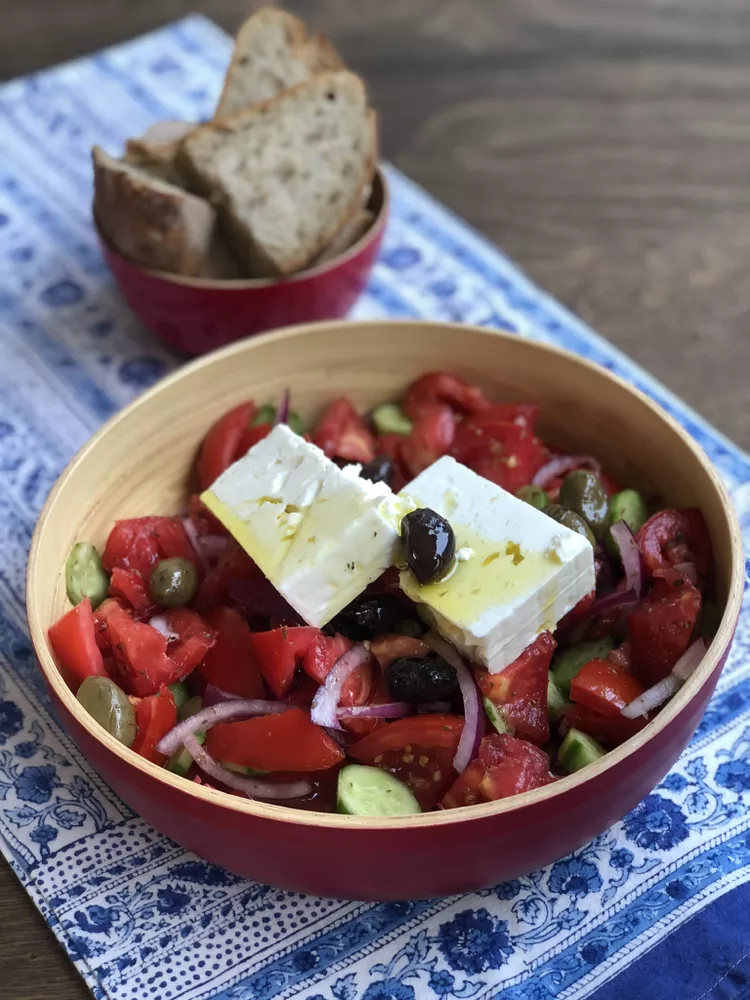
13) Horiatiki
Horiatiki, also known as Greek salad, is a classic dish from Greece. It’s simple yet full of flavor. All you need are fresh ingredients and basic seasoning.
For Horiatiki, use ripe tomatoes cut into wedges or chunks. Add sliced cucumbers, green bell pepper, and thinly sliced red onion. Kalamata olives bring a salty touch to the salad.
Top the vegetables with generous chunks of tangy feta cheese. Drizzle good quality extra virgin olive oil and a splash of red wine vinegar over everything. Add a sprinkle of dried oregano and a pinch of salt.
This salad doesn’t need a complicated dressing. The olive oil and vinegar mix with the juice from the tomatoes to coat everything. Serve it as a side dish or enjoy it as a light meal with some crusty bread.

14) Loukoumades
Loukoumades are small, round Greek donuts. They are known for being crispy on the outside and soft on the inside. These tasty treats are usually drizzled with honey and sprinkled with walnuts or cinnamon.
To make loukoumades, you need a few simple ingredients: flour, yeast, water, sugar, and milk. Start by mixing the yeast with warm water and a little sugar until it becomes frothy.
Add the flour, milk, and some olive oil to the yeast mixture. Knead the dough until it is smooth and elastic. Cover the dough with plastic wrap and let it rise in a warm place for about an hour until it doubles in size.
Once the dough has risen, heat some vegetable oil in a frying pan over medium heat. Test the oil’s temperature by dropping in a small piece of dough. If it sizzles and browns quickly, the oil is ready.
Scoop small amounts of dough and drop them into the hot oil. Fry the loukoumades until they are golden brown all over. Remove them from the oil and place them on a paper towel to drain any excess oil.
Drizzle the fried loukoumades with warm honey and sprinkle with chopped walnuts or cinnamon. Enjoy them while they are still warm for the best experience.
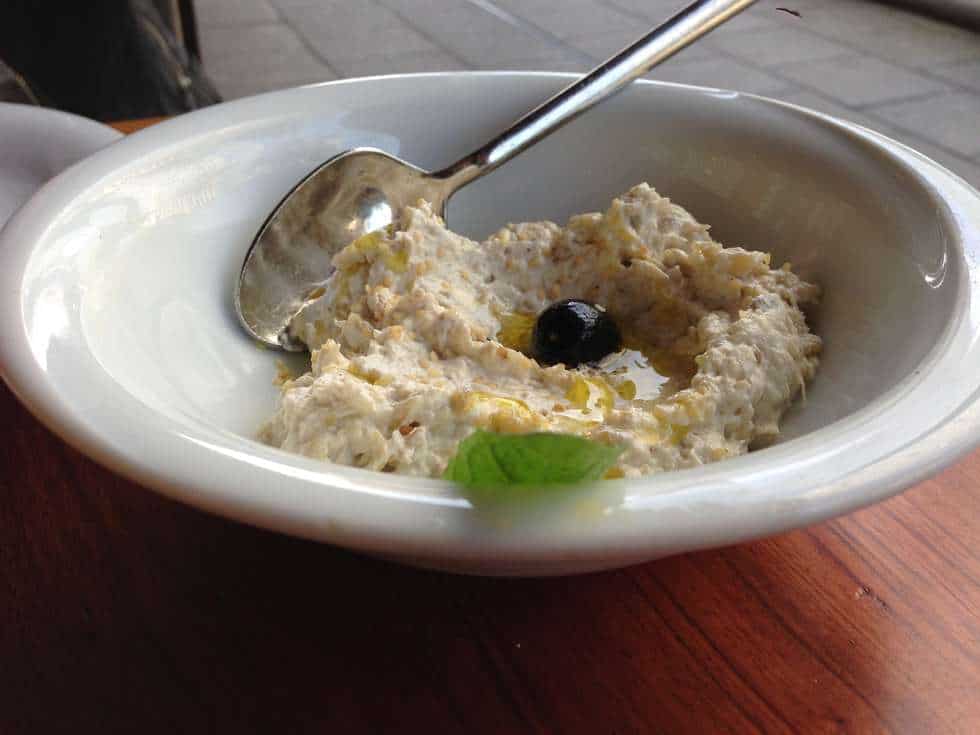
15) Melitzanosalata
Melitzanosalata is a traditional Greek dip made from roasted eggplant. It’s simple yet bursting with flavors. You start by roasting eggplants until their skin is charred.
After roasting, peel off the charred skin and discard. This step is crucial for that smoky taste. Next, chop the eggplant flesh and transfer it to a mixing bowl.
Add minced garlic, finely chopped onion, fresh parsley, lemon juice, and olive oil. These ingredients add a punch of freshness and zest. Add salt and pepper to taste.
Stir everything together until well combined. The texture should be creamy but still slightly chunky. Serve it with bread or pita for a delicious appetizer. Melitzanosalata can also be enjoyed as a spread or side dish.
The Rich History of Greek Cuisine
Greek cuisine has a long and varied history, shaped by ancient traditions and modern influences. The flavors and ingredients you find today have roots that stretch back through centuries of culinary evolution.
Ancient Greek Influences
Greek cuisine dates back to ancient times, around 350 B.C. The Greeks were among the first to cultivate olives and grapes, essential for making olive oil and wine, which remain key ingredients. They also valued simple meals, with a focus on fresh vegetables, fish, and legumes.
Herbs like oregano and basil, as well as spices, began to find their way into Greek kitchens early on. These elements came from trade relations with neighboring civilizations like the Persians, who introduced staples such as rice, yogurt, and honey-based sweets. The diet was well-balanced, emphasizing the use of natural and often local ingredients.
Modern Greek Food Culture
In modern times, Greek cuisine has continued to evolve while staying true to its roots. Influences from the Byzantine Empire brought exotic spices and complex sauces into the mix, enhancing traditional recipes. Dishes like moussaka and souvlaki are now household names.
Today’s Greek cooking also highlights slow-cooked dishes and the importance of communal meals. Foods like kleftiko, a slow-cooked lamb dish wrapped in parchment paper, showcase this tradition. Fresh produce, such as eggplants and zucchinis, along with legumes, are still widely used.
Moreover, the Mediterranean diet, part of modern Greek culture, is celebrated for its health benefits. This diet includes olive oil, fresh vegetables, lean proteins, and whole grains, and has influenced cuisine worldwide.
Essential Ingredients in Greek Cooking
Greek cuisine is known for its rich flavors, and this comes from the use of essential ingredients like olive oil and various herbs and spices. These elements are key to the authentic tastes of Greek dishes.
Olive Oil
Olive oil is a cornerstone of Greek cooking. It is made from pressing olives and is often used in salads, cooking, and dipping. Greeks take pride in their olive oil, which is renowned for its flavor and quality.
Cold-pressed extra virgin olive oil is commonly used due to its health benefits and pronounced taste. You can find it in almost every Greek dish, from simple salads like horiatiki to complex dishes like moussaka.
Key Uses:
- Drizzling over salads
- Cooking and frying
- As a dip for bread
Olive oil is not just a cooking ingredient but also central to Greek culture and lifestyle. It has been used for centuries, making it a true staple.
Herbs and Spices
Herbs and spices play a significant role in Greek recipes, defining the flavor profile of many dishes. Common herbs include oregano, thyme, and dill. These are often fresh but can also be used dried.
Common Herbs:
- Oregano: Often used in meat dishes and salads
- Thyme: Adds depth to soups and stews
- Dill: Key for flavoring fish dishes and tzatziki
Spices like cinnamon, nutmeg, and allspice are also important. These spices are usually used in savory dishes, such as pastitsio and dolmades, to create complex layers of flavor.
Key Uses:
- Oregano in Greek salad
- Cinnamon in meat sauces
- Dill in yogurt-based dips
Understanding the role of these herbs and spices is crucial for mastering Greek cooking and bringing out the authentic tastes of the region.








